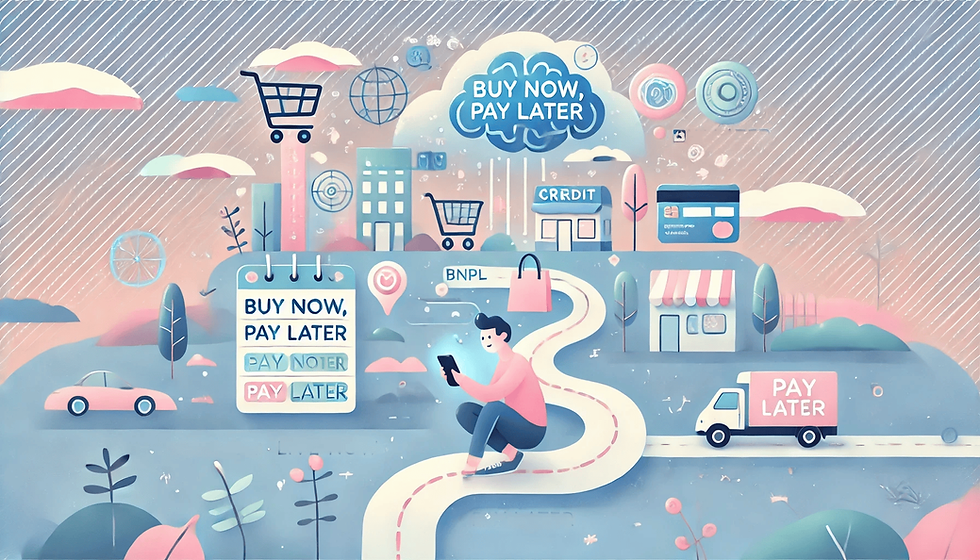Pay Later, Live Now: The Psychology Behind Flexible Finance
- Brand Wise

- Oct 31
- 4 min read

In recent years, one of the most popular financial trends has been the Buy Now, Pay Later (BNPL) model — a service that allows consumers to receive their desired product immediately while paying for it later in installments. This model combines convenience, flexibility, and instant gratification — factors that have fundamentally reshaped the way we spend.
BNPL services have influenced financial decision-making far beyond merely simplifying payment methods. They touch upon the psychological dimensions of finance — how we perceive money, plan budgets, and balance immediate desires with future responsibilities. This blog explores how the “pay later” model changes consumer behavior, affects financial awareness, and why it has become one of the most influential phenomena in modern fintech.
Table of Contents:
What Is BNPL and Why Has It Become So Popular?
Buy Now, Pay Later (BNPL) is an innovative payment model that allows users to receive products or services immediately and pay for them over time — often without additional fees or interest. It provides what traditional credit lacked: simplicity, transparency, and speed of access. For this reason, BNPL has become especially popular among younger generations who value instant comfort and flexible financial solutions.
Fintech companies quickly turned this model into a daily shopping companion. The growth of e-commerce and digital payments made BNPL a universal tool — from small purchases to major financial commitments. Its success lies in the combination of immediate satisfaction and deferred payment, making it both convenient and psychologically appealing.
The Economy of Instant Gratification: The Psychology Behind “Buy Now, Pay Later”
The BNPL model taps into one of the strongest psychological drivers — the desire for instant gratification. People naturally want to obtain what they want immediately, even when their finances might not fully allow it. The “Buy Now, Pay Later” system caters precisely to this impulse, allowing consumers to purchase now and postpone payment — temporarily distancing themselves from the sense of financial responsibility.
This approach has significantly affected spending behavior. Money is no longer perceived as a constraint but as a flexible resource managed by technology. As a result, consumers often make quicker and more emotional purchasing decisions than with traditional payment models. BNPL creates an illusion of financial freedom, but it also demands stronger self-control to ensure that short-term satisfaction does not undermine long-term financial stability.
How BNPL Is Changing Consumer Spending Habits
BNPL has altered consumer financial behavior on a daily level. In the past, people planned major purchases in advance; now, they can make immediate decisions since payments are split into installments. This boosts consumer activity, especially in e-commerce, where one click is enough to buy. Consequently, users make more frequent but smaller purchases, increasing overall spending volume.
BNPL also changes how users view financial obligations. Traditional credit was often seen as stressful or bureaucratic, whereas BNPL feels easy and accessible. This fosters the impression that financial responsibility is more manageable. However, experts warn that such flexibility can lead to unnoticed debt accumulation — especially when users rely on multiple BNPL services simultaneously. For this reason, financial literacy is crucial to ensure that “pay later” remains a benefit, not a risk.
Risks and Responsibility in a Flexible Financial Model
Although BNPL offers convenience and flexibility, overuse can lead to financial strain. The main danger lies in the illusion of affordability — deferred payments can make expenses feel smaller or less significant. Over time, users may take on more obligations than their budgets allow. Multiple small payments can accumulate into significant debt, especially for those who do not actively monitor their spending.
Strengthening financial responsibility has therefore become one of the key challenges within the BNPL ecosystem. Fintech companies are responding by investing in consumer education — providing spending dashboards, automatic reminders, and payment tracking tools. The goal is for users not only to enjoy flexible payments but to stay aware of their financial commitments. Ultimately, BNPL’s long-term success depends not only on its technology but on how responsibly consumers use it.
Future Outlook: Could BNPL Become a Financial Standard?
BNPL services are shaping a new financial culture where payment is no longer a barrier to purchase decisions. The trend has grown so rapidly that in many countries, BNPL is now a standard feature of banks, e-commerce platforms, and fintech ecosystems. In the future, BNPL may become as common as paying by card or digital wallet — especially if the industry continues to prioritize transparency and consumer education.
However, for BNPL to evolve into a sustainable financial instrument rather than a temporary trend, regulation, education, and accountability must advance together. Consumers need to learn how to use flexibility wisely, and companies must ensure fair practices and clear terms. Ultimately, BNPL represents the intersection of psychology, technology, and finance — a model that empowers people with freedom, provided they maintain a responsible balance.



Comments